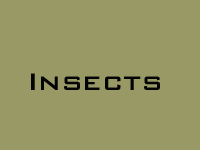
 |
|
|
|
|
|
|
 |
|
Insects The phylum Arthropoda (Greek
for "jointed legs") comprises four major groups: Uniramia (insects and
their allies), Chelicerata (such as spiders and scorpions), Crustacea
(the often-eaten lobsters and shrimps are in this group) and the extinct
Trilobitomorpha (trilobites). Insects are by far the most successful animal
group on the planet. Of the 1.5-1.8 million species that have been identified,
over 750 000 Insects owe their success to several features. The first of these is their rigid, protective exoskeleton (external skeleton). The rigidity of the exoskeleton means that they must shed it to grow; species go through many moults and some undergo complete metamorphosis before they reach adult size. Their bodies are segmented, with many of the segments fused into specialized functional units. A small size and amazing reproductive ability also help. They are also one of only three groups to fly, the other two being the birds and bats. Approximately thirty-five orders of insects are known, including the Diptera (flies), Coleoptera (beetles), Lepidoptera (butterflies and moths), Hymenoptera (bees and ants) and Siphonaptera (fleas). The beetles are the most successful order of the insects, numbering about 300 000 described species! This section contains information on 150 of Canada's insects species, divided into five parts: Page 2 Beetles (the order Coleoptera) Page 3 Flies (the order Diptera) Page 4 Ants, bees, and true bugs (the orders Hymenoptera and Hemiptera) Page 5 Butterflies, moths and skippers (the order Lepidoptera) Page 6 Other insects
|